|
Balance
Sheet
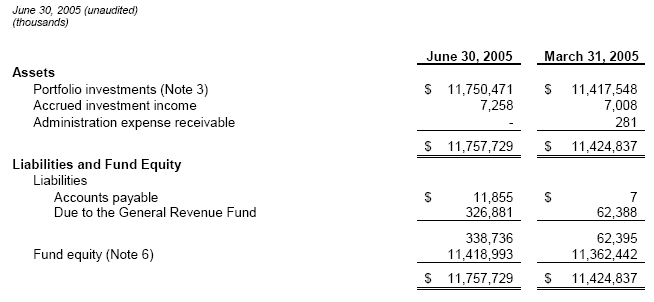

Statement
of Operations
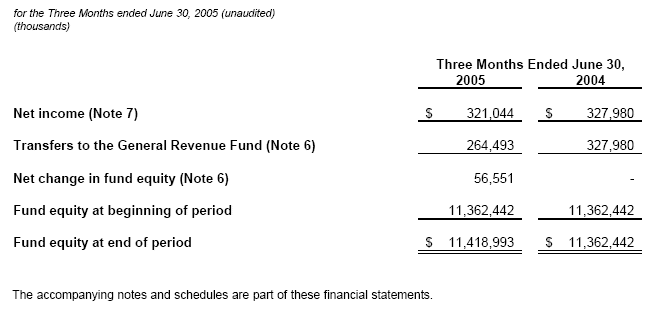

Statement
of Cash Flow


Notes
to the Financial Statements
June
30, 2005 (unaudited)
NOTE
1 AUTHORITY AND MISSION
The Alberta Heritage Savings Trust
Fund operates under the authority of the Alberta Heritage
Savings Trust Fund Act (the Act), Chapter A-23, Revised Statutes
of Alberta 2000, as amended.
The preamble to the Act describes
the mission of the Fund as follows:
"To provide prudent stewardship
of the savings from Alberta's non-renewable resources by providing
the greatest financial returns on those savings for current and
future generations of Albertans."
NOTE
2 SUMMARY OF SIGNIFICANT ACCOUNTING POLICIES AND REPORTING PRACTICES
The recommendations of the Public
Sector Accounting Board of the Canadian Institute of Chartered
Accountants are the primary source for the disclosed basis of
accounting. Recommendations of the Accounting Standards Board
of the Canadian Institute of Chartered Accountants, other authoritative
pronouncements, accounting literature, published financial statements
relating to either the public sector or analogous situations in
the private sector are used to supplement the recommendations
of the Public Sector Accounting Board where it is considered appropriate.
The accounting policies of significance
to the Fund are as follows:
(a) Portfolio
Investments
Fixed-income securities, mortgages,
equities, real estate investments, absolute return strategies
and timberland investments held directly by the Fund or by pooled
investment funds are recorded at cost. Cost includes the amount
of applicable amortization of discount or premium using the straight-line
method over the life of the investments.
Investments in loans
are recorded at cost less any allowance for credit loss. Where
there is no longer reasonable assurance of timely collection of
the full amount of principal and interest of a loan, a specific
provision for credit loss is made and the carrying amount of the
loan is reduced to its estimated realizable amount.
Investments are recorded
as of the trade date.
The cost of disposals
is determined on the average cost basis.
Where there has been
a loss in value of an investment in fixed-income securities, mortgages,
equities, real estate and absolute return strategies that is other
than a temporary decline, the investment is written down to recognize
the loss. The written down value is deemed to be the new cost.
(b) Investment
Income
Investment income is recorded on the accrual
basis where there is reasonable assurance as to its measurement
and collectability. When a loan becomes impaired, recognition
of interest income in accordance with the terms of the original
loan agreement ceases.
Any subsequent
payments received on an impaired loan are applied to reduce the
loan's book value.
Gains and losses
arising as a result of disposals of investments are included in
the determination of investment income.
Income and expense
from derivative contracts are included in investment income. Certain
derivative contracts, which are primarily interest rate swaps
and cross-currency interest rate swaps, are designated as hedges
of market risks for purposes of hedge accounting. Hedge accounting
recognizes gains and losses from derivatives in the statement
of income in the same period as the gains and losses of the security
being hedged. As a result, income and expense from derivative
contracts designated as hedges are recognized in income on an
accrual basis with gains and losses recognized in income to the
extent realized.
Where a hedge
relationship is designated, the hedge is documented at inception.
The documentation identifies the specific asset being hedged,
the risk that is being hedged, type of derivative used and the
matching of critical terms of both the hedged security and the
hedging derivative for purposes of measuring effectiveness. The
derivative must be highly effective in accomplishing the objective
of offsetting either changes in the fair value or cash flows attributable
to the risk being hedged both at inception and over the life of
the hedge.
Derivative contracts
not designated as hedges for purposes of hedge accounting, which
are primarily bond index swaps, equity index swaps, equity index
futures, forward foreign exchange contracts and credit default
swap contracts, are recorded at fair value.
(c) Foreign
Currency
Foreign currency transactions
are translated into Canadian dollars using average rates of exchange
except for hedged foreign currency transactions, which are translated
at rates of exchange, established by the terms of the forward
exchange contracts. Exchange differences on unhedged transactions
are included in the determination of investment income.
(d) Investment
Valuation
Portfolio investments are recorded
in the financial statements at cost. The fair value of investments
is provided for information purposes and is disclosed in Note
3.
Fair value is the amount
of consideration agreed upon in an arm's length transaction between
knowledgeable, willing parties who are under no compulsion to
act.
Measurement uncertainty
exists in the fair values reported for certain investments such
as private equities, private real estate, loans, absolute return
strategies and other private placements. The fair values of these
investments are based on estimates where quoted market prices
are not readily available. Estimated fair values may not reflect
amounts that could be realized upon immediate sale, nor amounts
that ultimately may be realized.
Accordingly, the estimated
fair values may differ significantly from the values that would
have been used had a ready market existed for these investments.
Fair value of investments
held either directly by the Fund or by pooled investment funds
are determined as follows:
(i) Public fixed-income
securities and equities are valued at the period-end closing
sale price, or the average of the latest bid and ask prices
quoted by an independent securities valuation company.
(ii) Mortgages, provincial corporation debentures and private
fixed-income securities are valued based on the net present
value of future cash flows. These cash flows are discounted
using appropriate interest rate premiums over similar Government
of Canada benchmark bonds trading in the market.
(iii) The fair value of private equities is estimated by managers
or general partners of private equity funds, pools and limited
partnerships. Valuation methods may encompass a broad range
of approaches. The cost approach is used to value companies
without either profits or cash flows. Established private companies
are valued using the fair market value approach reflecting conventional
valuation methods including discounted cash flows and multiple
analysis.
(iv) The fair value of real estate investments is reported at
the most recent appraised value, net of any liabilities against
the real property. Real estate properties are appraised annually
by qualified external real estate appraisers. Appraisers use
a combination of methods to determine fair value including replacement
cost, direct comparison, direct capitalization of earnings and
discounted cash flows.
(v) The fair value of absolute return strategy investments is
estimated by external managers.
(vi) The fair value of loans is estimated by management based
on the present value of discounted cash flows.
(vii) The fair value of timberland investments is appraised
annually by independent third party evaluators.
(viii) The fair value of deposits, receivables, accrued interest
and payables is estimated to approximate their book values.
(ix) The fair value of investments and any other assets and
liabilities denominated in a foreign currency are translated
at the year-end exchange rate.
(e)
Valuation of Derivative Contracts
Derivative contracts include equity and bond index swaps, interest
rate swaps, cross-currency interest rate swaps, credit default
swaps, forward foreign exchange contracts and equity index futures
contracts. As disclosed in Note 4, the value of derivative contracts
is included in the fair value of pooled investment funds. The
estimated fair value of derivative contracts at the reporting
date is determined by the following methods:
(i) Equity and bond
index swaps are valued based on changes in the appropriate market
based index net of accrued floating rate interest.
(ii) Interest rate swaps and cross-currency interest rate swaps
are valued based on discounted cash flows using current market
yields and exchange rates.
(iii) Credit default swaps are valued based on discounted cash
flows using current market yields and calculated default probabilities.
(iv) Forward foreign exchange contracts and equity index futures
contracts are valued based on quoted market prices.
NOTE
3 PORTFOLIO INVESTMENTS
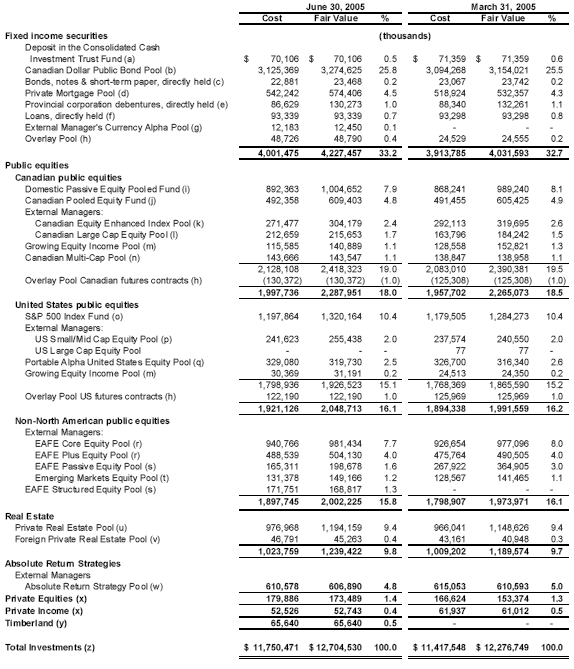
The majority of the
Fund's investments are held in pooled investment funds established
and administered by Alberta Finance. Pooled investment funds have
a market based unit value that is used to allocate income to participants
and to value purchases and sales of pool units. As at June 30,
2005, the Fund's percentage ownership, at market, in pooled investment
funds is as follows:

(a) The Consolidated Cash Investment
Trust Fund is managed with the objective of providing competitive
interest income to depositors while maintaining appropriate security
and liquidity of depositors' capital. The portfolio is comprised
of high-quality short-term and mid-term fixed-income securities
with a maximum term-to-maturity of three years. As at June 30,
2005, securities held by the Fund have an average effective market
yield of 2.65% per annum (March 31, 2005: 2.79% per annum).
(b) The Canadian Dollar Public Bond
Pool is managed with the objective of providing above average
returns compared to the total return of the Scotia Capital Universe
Bond Index over a four-year period while maintaining adequate
security and liquidity of participants' capital. The excess return
is achieved through management of portfolio duration and sector
rotation. The portfolio is comprised of high quality Canadian
fixed-income instruments and debt related derivatives. As at June
30, 2005, securities held by the Pool have an average effective
market yield of 3.90% per annum (March 31, 2005: 4.48% per annum)
and the following term structure based on principal amount: under
1 year: 2% (March 31, 2005: 3%); 1 to 5 years: 37% (March 31,
2005: 38%); 5 to 10 years: 31% (March 31, 2005: 31%); 10 to 20
years: 13% (March 31, 2005: 12%); and over 20 years: 17% (March
31, 2005: 16%).
(c) As at June 30, 2005, fixed-income
securities held directly by the Fund have an average effective
market yield of 2.90% per annum (March 31, 2005: 3.18% per annum).
As at June 30, 2005, fixed-income securities have the following
term structure based on principal amount: under two years: 100%
(March 31, 2005: 100%).
(d) The Private Mortgage Pool is
managed with the objective of providing investment returns higher
than attainable from the Scotia Capital Universe Bond Index over
a four-year period or longer. The portfolio is comprised primarily
of high quality commercial mortgage loans (94.0%) and provincial
bond residuals (6.0%). To limit investment risk, mortgage loans
are restricted to first mortgage loans, diversified by property
usage and geographic location, and include a small portion of
NHA insured loans. As at June 30, 2005, securities held by the
Pool have an average effective market yield of 4.65% per annum
(March 31, 2005: 5.29% per annum) and the following term structure
based on principal amount: under 1 year: 3% (March 31, 2005: 2%);
1 to 5 years: 21% (March 31, 2005: 22%); 5 to 10 years: 43% (March
31, 2005: 43%); 10 to 20 years: 11% (March 31, 2005: 12%); and
over 20 years: 22% (March 31, 2005: 21%).
(e) As at June 30, 2005, Provincial
corporation debentures have an average effective market yield
of 7.17% per annum (March 31, 2005: 7.51% per annum) and the following
term structure based on principal amounts: 5 to 10 years: 100%
(March 31, 2005: 100%).
(f) Investments in loans are recorded
at cost. The fair value of loans is estimated by management based
on the present value of discounted cash flows. As at June 30,
2005, investment in loans, at cost, include the Ridley Grain loan
amounting to $91,245 (March 31, 2005: $91,245) and the Vencap
loan amounting to $2,094 (March 31, 2005: $2,053). The increase
in the carrying value of the Vencap loan resulted from amortization
of the loan on a constant yield basis.
- Under the
terms of the loan to Ridley Grain, 11% Participating First Mortgage
Bonds due July 31, 2015, interest is compounded semi-annually
and payable annually to the extent of available cash flow and
any shortfall is to be deferred and capitalized. The principal
of $91,245 and deferred interest is repayable on or before July
31, 2015. Deferred interest at June 30, 2005 amounted to $92,517
(March 31, 2005: $92,517). Grain throughput volumes are the
main determinant of profitability of the grain terminal and
the value of the loan to the Fund. Due to the uncertainty of
forecasting the grain throughput volumes, income from the participating
bonds is recognized when it is measurable and collectable.
- The principal
amount of the Vencap loan, amounting to $52,588 is due July
2046 and bears no interest.
(g)The External Managers Currency
Alpha Pool is managed with the objective of providing a fair return
over a four-year moving period while reducing return volatility
through multiple manager investment style and strategies. The
return is achieved through active currency management with currency
positions established primarily through forward foreign exchange
contracts. Participants deposit into the Pool a modest amount
of cash to minimize rebalancing of cash flows in or out of the
Pool when the forward foreign exchange contracts settle.
(h) The Overlay Pool provides participants
with a quick, effective and efficient means to achieve tactical
asset allocation opportunities without incurring undue transaction
costs in the underlying investments. Long or short exposures to
respective asset classes are obtained through synthetic instruments
on a largely unfunded basis using equity index futures contracts.
Approximately 5% to 10% of the Pool's notional exposure in Canadian
and US futures contracts is supported by cash and short-term securities.
The Overlay Pool is comprised of the "long" position
through US futures contracts, the "short" position through
Canadian futures contracts, and the "cash securities"
position through money market securities. Taken together these
three positions reduce exposure to Canadian equities and increase
exposure to U.S. equities.
(i) The Domestic Passive Equity Pooled
Fund is managed on a passive approach with the objective of providing
investment returns comparable to the Toronto Stock Exchange S&P/TSX
Composite Index. The portfolio is comprised of publicly traded
Canadian equities and structured investments replicating the S&P/TSX
60 Index. The Pool's investment in units of the Floating Rate
Note Pool (FRNP) are used as the underlying securities to support
the index swaps of the pool. FRNP is managed with the objective
of generating floating rate income needed for the swap obligations
in respect of structured investments in foreign equities, domestic
equities and domestic bonds. Through the use of interest rate
swaps, FRNP provides investment opportunities in high quality
floating-rate instruments with remaining term-to-maturity of five
years or less.
(j) The Canadian Pooled Equity Fund
is managed with the objective of providing competitive returns
comparable to the total return of the S&P/TSX Composite Index
while maintaining maximum preservation of participants' capital.
The portfolio is comprised of publicly traded equities in Canadian
corporations. Risk is reduced by prudent security selection while
remaining sector neutral.
(k) The externally managed Canadian
Equity Enhanced Index Pool allows participants the opportunity
to gain investment exposure to the Canadian large cap equity market.
The performance objective is to provide returns higher than the
total return of the S&P/TSX Composite Index over a four-year
moving average period. The portfolio is comprised of publicly
traded equities in Canadian corporations. The enhanced index generates
a consistent level of return above the Index with relatively low
risk.
(l) The Canadian Large Cap Equity
Pool consists of multiple portfolios of publicly traded Canadian
equities. The portfolios are actively managed by external managers
with expertise in the Canadian large cap equity market. The performance
objective is to provide returns higher than the total return of
the S&P/TSX Composite Index over a four-year period. Return
volatility is reduced through multiple manager investment style
and market capitalization focus.
(m) The Growing Equity Income Pool
is managed with the objective of providing a steady and growing
stream of dividend income by investing in mature Canadian and
US companies with strong financial characteristics and growing
distributions. Risk is reduced by holding established, well-capitalized
companies. The performance of the pool is measured against the
total return of a custom S&P/TSX Composite Index for dividend
paying stocks.
(n) The Canadian Multi-Cap Pool allows
participants to gain investment exposure to the Canadian equity
market through internally managed structured investments replicating
the S&P/TSX 60 Index and external actively managed Canadian
small and mid cap investments. The performance of the pool is
measured against the total return of the S&P/TSX Composite
Index over a four-year moving average period.
(o) Publicly traded US equities held
in the S&P 500 Index Fund replicate the Standard & Poor's
(S&P) 500 Index. The performance objective is to provide returns
comparable to the total return of the S&P 500 Index over a
four-year period. The Pool's investment in units of the Floating
Rate Note Pool (FRNP) are used as the underlying securities to
support the index swaps of the pool.
(p) The US Small/Mid Cap Equity Pool
consists of one portfolio of publicly traded United States equities.
The portfolio is actively managed by an external manager with
expertise in the small cap and mid cap US equity market. The performance
objective is to provide returns higher than the total return of
the Russell 2500 Index over a four-year period.
(q) The Portable Alpha United States
Equity Pool consists of futures and swap contracts which provide
exposure to the U.S. equity market by replicating the S&P
500 Index and investments in value added absolute return strategies.
The performance objective is to provide returns higher than the
total return of the Standard & Poor's (S&P) 500 Index
over a four-year period.
(r) The Europe, Australasia and Far
East (EAFE) Core and Plus Equity Pools consist of multiple portfolios
of publicly traded non-North American equities. EAFE Core portfolios
are actively managed by external managers with European and Pacific
Basin mandates. EAFE core managers have constraints on foreign
currency management and deviations from the MSCI EAFE Index asset
mix by country. The EAFE Plus portfolios are actively managed
by external managers with less constraints on country allocation,
stock selection, currency management and investments in emerging
markets. The performance objective is to provide returns higher
than the total return of the Morgan Stanley Capital International
(MSCI) EAFE Index over a four-year period.
(s) The externally managed EAFE Passive
Equity Pool and the internally managed EAFE Structured Equity
Pool are managed with the objective to provide returns comparable
to the total return of the MSCI EAFE Index over a four year period.
The EAFE Passive Equity Pool consists of one portfolio of non-North
American publicly traded equities that replicates the MSCI EAFE
Index. The EAFE Structured Equity Pool provides exposure to EAFE
markets through the use of structured investments such as foreign
equity index swaps. The structured pool also invests in the Floating
Rate Note Pool to generate the floating rate cash flows needed
for its equity swap obligations.
(t) The External Managers Emerging
Markets Equity Pool consists of publicly traded equities in emerging
markets around the world. The portfolio is actively managed by
external managers with expertise in emerging markets. The performance
objective is to provide returns higher than the total return of
the Morgan Stanley Capital International Index Emerging Markets
Free (MSCI EMF) Index over a four-year period.
(u) The Private Real Estate Pool
is managed with the objective of providing investment returns
higher than the IPD Large Institutional All Property Index. Real
estate is held through intermediary companies, which have issued
to the Pool, common shares and participating debentures secured
by a charge on real estate. Risk is reduced by investing in properties
that provide diversification by geographic location, by property
type and by tenancy. As real estate returns are positively correlated
to inflation and negatively correlated to returns from fixed income
securities and equities, the Pool provides diversification from
the securities market with opportunities for high return.
(v) The Foreign Private Real Estate
Pool is managed with the objective of providing investment returns
higher than the IPD Large Institutional All Property Index. The
Pool provides diverse exposure to non-domestic real estate by
investing in foreign real estate backed securities and assets.
(w) The Absolute Return Strategy
Pool is managed with the objective of providing investment returns
higher than the Consumer Price Index (CPI) plus 6%. The Pool uses
external managers who employ various investment strategies. These
strategies are expected to produce absolute positive investment
returns with lower volatility.
(x) Private Equity Pools are managed
with the objective of providing investment returns higher than
the Consumer Price Index (CPI) plus 8.0%. The Private Equity Portfolio
consists of the Private Equity Pool, PEP98, PEP02, PEP04 and the
Foreign Private Equity Pool 2002. Private equity investments are
held in institutionally sponsored private equity pools. Risk is
reduced by avoiding direct investments in private companies and
by limiting holdings in any single pool. The Private Income Pool
invests in infrastructure related projects that are structured
to yield high current income with the objective of providing investment
returns higher than the CPI plus 6.0%.
(y) The Timberland Pool provides
high current income and long investment horizons. The performance
objective is to earn a return higher than CPI plus 4.0%.
(z ) Where there has been a loss
in value of an investment that is other than a temporary decline,
the cost of the investment is written down to recognize the loss
(see Note 2 (a)). Where the fair value remains less than cost,
after recording a writedown, it is management's best judgement
that the decline in value is caused by short-term market trends
and is temporary in nature.
NOTE
4 DERIVATIVE CONTRACTS
Derivative contracts
are financial contracts, the value of which is derived from the
value of underlying assets, indices, interest rates or currency
rates. The Fund uses derivative contracts held indirectly through
pooled investment funds to enhance return, manage exposure to
interest rate risk and foreign currency risk and for asset mix
management purposes. The notional value of a derivative contract
represents the amount to which a rate or price is applied in order
to calculate the exchange of cash flows.
(i) A swap is a contractual agreement
between two counter-parties to exchange a series of cash flows
based on a notional amount. An equity or bond index swap involves
the exchange of a floating interest rate cash flow for one based
on the performance of a market index. For interest rate swaps,
parties generally exchange fixed and floating rate interest cash
flows based on a notional amount. Cross-currency interest rate
swaps are contractual obligations in which the principal amounts
of Canadian fixed-income securities denominated in foreign currency
are exchanged for Canadian currency amounts both initially and
at maturity. Over the term of the cross-currency swap, counter-parties
exchange fixed to fixed and fixed to floating interest rate cash
flows in the swapped currencies. A credit default swap allows
counter-parties to buy and sell protection on credit risk inherent
in a bond. A premium is paid, based on a notional amount, from
one counter party to a second counter party in exchange for a
contingent payment should a defined credit event occur with respect
to the underlying security. There are underlying securities supporting
all swaps. Leveraging is not allowed.
(ii) Forward foreign exchange contracts
are contractual agreements to exchange specified currencies at
an agreed upon exchange rate and on an agreed settlement date
in the future.
(iii) An equity index futures contract
is an agreement to receive or pay cash based on changes in the
level of the specified stock index.
The following is a summary
of the fund's proportionate share of the notional amount and fair
value of derivative contracts held by pooled funds at June 30,
2005.
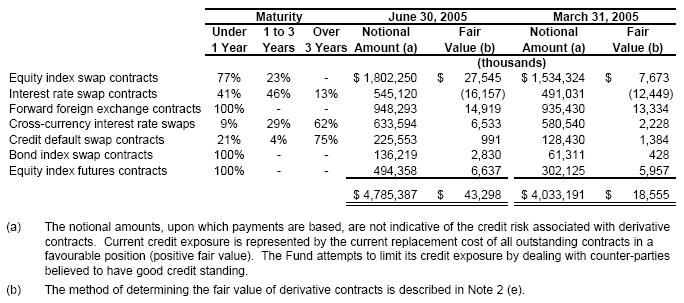
NOTE
5 INVESTMENT RISK MANAGEMENT
Income and financial
returns of the Fund are exposed to credit risk and price risk.
Credit risk relates to the possibility that a loss may occur from
the failure of another party to perform according to the terms
of a contract. Price risk is comprised of currency risk, interest
rate risk and market risk. Currency risk relates to the possibility
that the investments will change in value due to future fluctuations
in foreign exchange rates. Interest rate risk relates to the possibility
that the investments will change in value due to future fluctuations
in market interest rates. Market risk relates to the possibility
that the investments will change in value due to future fluctuations
in market prices.
The Standing Committee on the Alberta
Heritage Savings Trust Fund reviews and approves the business
plan of the Fund. In order to earn an optimal financial return
at an acceptable level of risk, the 2005-08 Business Plan proposed
the following asset mix policy for the Fund:
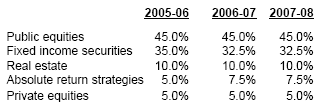
Subsequent to the release
of the 2005-08 Business Plan, the long-term asset mix policy for
2007-08 was amended. Fixed income securities were reduced from
32.5% to 30.0%, absolute return strategies were reduced from 7.5%
to 6.0%, private equities are reduced from 5.0% to 4.0%, private
income and timberland investments are added at 3.0% and 2.0% respectively.
Risk is reduced through asset class diversification, diversification
within each asset class, quality and duration constraints on fixed-income
instruments, and restrictions on amounts exposed to countries
designated as emerging markets. Controls are in place respecting
the use of derivatives (see Note 4). Forward foreign exchange
contracts may be used to manage currency exposure in connection
with securities purchased in foreign currency (see Note 4).
NOTE
6 FUND EQUITY
Section 8 (2) of the
Alberta Heritage Savings Trust Fund Act (the Act) states
that the net income of the Heritage Fund less any amount retained
in the Fund to maintain its value shall be transferred to the
General Revenue Fund annually in a manner determined by the Minister
of Finance.
The estimated amount retained in
the Fund for inflation proofing is determined by multiplying the
total equity as recorded on the financial statements by the percentage
increase in the Canadian gross domestic product (GDP) price index
for the period.
NOTE
7 NET INCOME (LOSS)
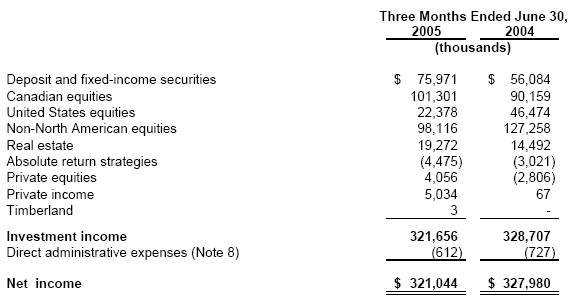
Investment income is
comprised of interest, dividends, amortization of discount and
premiums, swap income, security lending income and realized gains
and losses, net of writedowns, on investments. The Fund's share
of income earned from externally and internally managed investment
pools is net of administrative expenses incurred by the pools
(see Note 8).
The investment income for the period
ended June 30, 2005 includes writedowns totalling $1,595 (June
30, 2004: $Nil).
NOTE
8 ADMINISTRATIVE EXPENSES
Administrative expenses
include investment management, cash management, safekeeping costs
and other expenses charged on a cost-recovery basis directly from
Alberta Finance. The Fund's total administrative expense for the
period, including amounts deducted directly from investment income
of pooled funds is as follows:

NOTE
9 INVESTMENT PERFORMANCE
The following is a summary
of the overall investment performance results attained by the
Fund determined on a fair value basis:

* The overall benchmark
return for the three months ended June 30, 2005 is a product of
the weighted average policy sector weights and the sector benchmark
returns. The Fund is expected to generate a real rate of return
of 4.5% over a moving five-year period based on the Fund's business
plan. Over a five-year period, the annualized inflation rate was
2.4%. Therefore, the fund is expected to generate a nominal annualized
rate of return of 6.9%.
NOTE
10 APPROVAL OF FINANCIAL STATEMENTS
The Deputy Minister
of Finance approved these financial statements.

|










